Environmental justice champions should do more to raise awareness of and community engagement in popular federal actions such as Justice40.
Our Focus on Environmental Justice
In collaboration with our Multisector Partner Group, the AAMC Center for Health Justice identified environmental justice as its fourth focus area and one of the most pressing health equity issues facing people across the United States. Through comment letters, our forthcoming Community Voices for Action storytelling campaign, and participation in national environmental justice-related efforts such as the National Academy of Medicine (NAM) Climate Communities Network (CCN), the Center hopes to ensure all communities benefit from a thriving natural world.1
Environmental justice and health justice are interconnected because environmental factors greatly influence health outcomes, with Black, Hispanic, Indigenous, and low-income communities disproportionately bearing environmental injustices, resulting in various health inequities.2 3
In April 2024, the Center conducted a poll with a nationally representative sample (n = 3,207) focused on gauging perspectives around environmental hazards,4 environmental injustice,5 and environmental justice.6 We were interested in exploring U.S. adults’ awareness and perceived impacts of these topics, their level of agreement with environmental justice principles, and their level of awareness and support for federal policies and programs that are focused on promoting environmental health and justice.
Public Awareness of Environmental Hazards
Among U.S. adults, there is strong awareness (70%) that environmental hazards exist within the United States, though that awareness gradually declines at state (58%), city/town (50%), and neighborhood levels (41%).
At the neighborhood level, racial and ethnic differences emerge, with Black Americans (57%) more aware of environmental hazards than Asian Americans (40%), Native Americans, Alaska Natives, Native Hawaiians, and Pacific Islanders (39%), whites (38%), and Hispanics (46%). Further, adults residing in urban areas (51%) are more aware of neighborhood-level hazards than are their suburban (46%) or rural (42%) counterparts. There is also a generational difference, with Gen Zers and millennials (both 50%) more likely than Gen Xers (39%) and baby boomers (30%) to report neighborhood-level environmental hazards.
Among adults who are aware of environmental hazards in their neighborhood, city/town, and/or state, a majority believe they have been exposed to extreme weather events (66%) or poor outdoor air quality (54%) (see supplemental table 1).
Differential Impacts of Environmental Hazards
While a majority (61%) of U.S. adults correctly believe that low-income groups are more likely than high-income ones to be exposed to environmental hazards,7 8 less than half believe differences in environmental hazard exposure are related to race. Only 44% of U.S. adults think that communities of color are more likely to be exposed to environmental hazards than white communities, despite significant evidence that they are (Figure 1).9 10 11 12 13
Interestingly, respondents who earned less than $50,000 (the lowest income category in our sample) are the least likely to believe they are disproportionately impacted by environmental hazard exposure, though the majority (57%) still believe this. While self-identified liberals (65%) and conservatives (63%) are equally likely to recognize income-based environmental hazard exposure, ideological differences are marked when it comes to race/ethnicity-based exposure: 63% of self-identified liberals but only 37% of their conservative counterparts believe communities of color are more likely to be exposed to environmental hazards than white communities are.
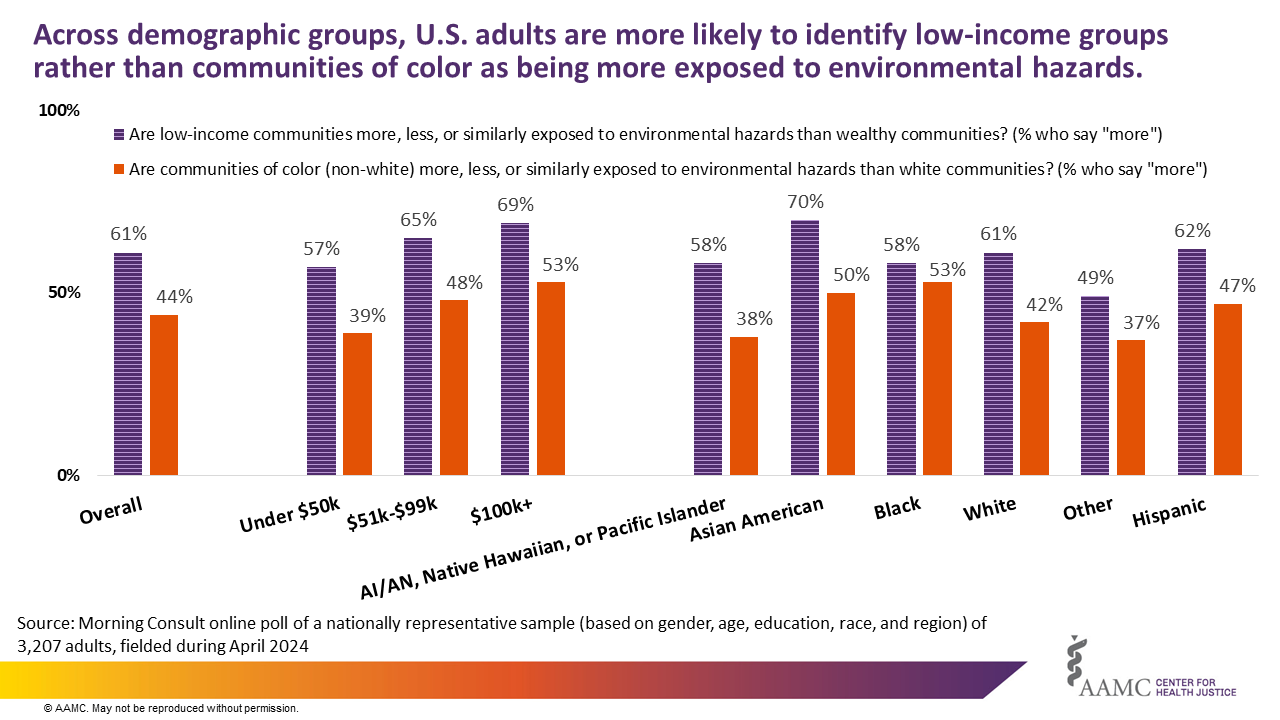
Awareness of Environmental Injustice
A majority (62%) of U.S. adults believe that environmental injustice is a problem nationally, while a lower number believe it is a problem in their state (48%) or city/town (38%). There is greater acknowledgment of environmental hazards at all geographic levels than there is for environmental injustice, and the differences increase as the geographic level decreases (Figure 2).
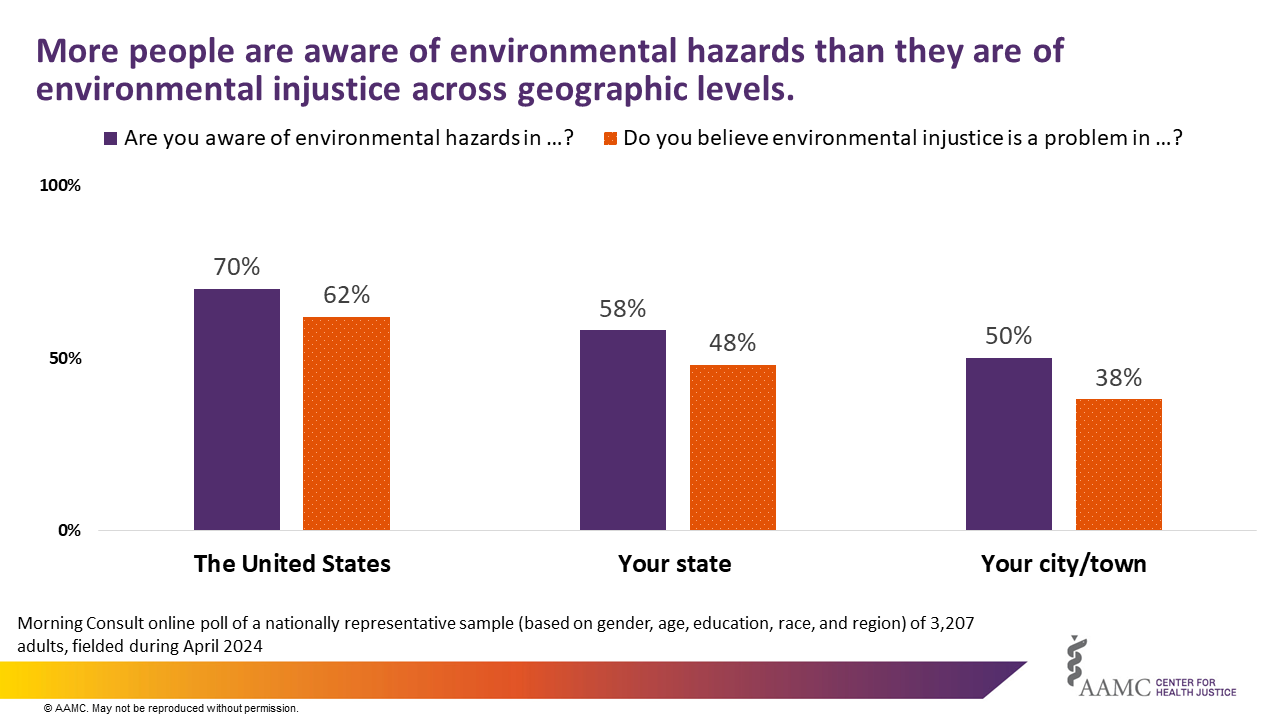
Patterns of demographic-group differences emerge across national, state, and local levels regarding the belief that environmental injustice is a problem. Generally, Black adults, urban-dwelling adults, adults with more years of education, younger adults, and those who identify as liberal are more likely to perceive environmental injustice as a problem (see supplemental table 2).
While an earlier question asked respondents which groups they thought were more likely to be exposed to environmental hazards, we next asked them which groups in the United States are most likely to bear the burden of environmental injustice (Figure 3). Framing mattered: While 61% of respondents had said low-income groups were more likely to be exposed to hazards, only 47% said that group was more likely to be faced with environmental injustice. Similarly, though 44% of those polled had reported that racial and ethnic minorities were more likely to face increased exposure to environmental hazards, only 33% said that group was more likely to face environmental injustice.
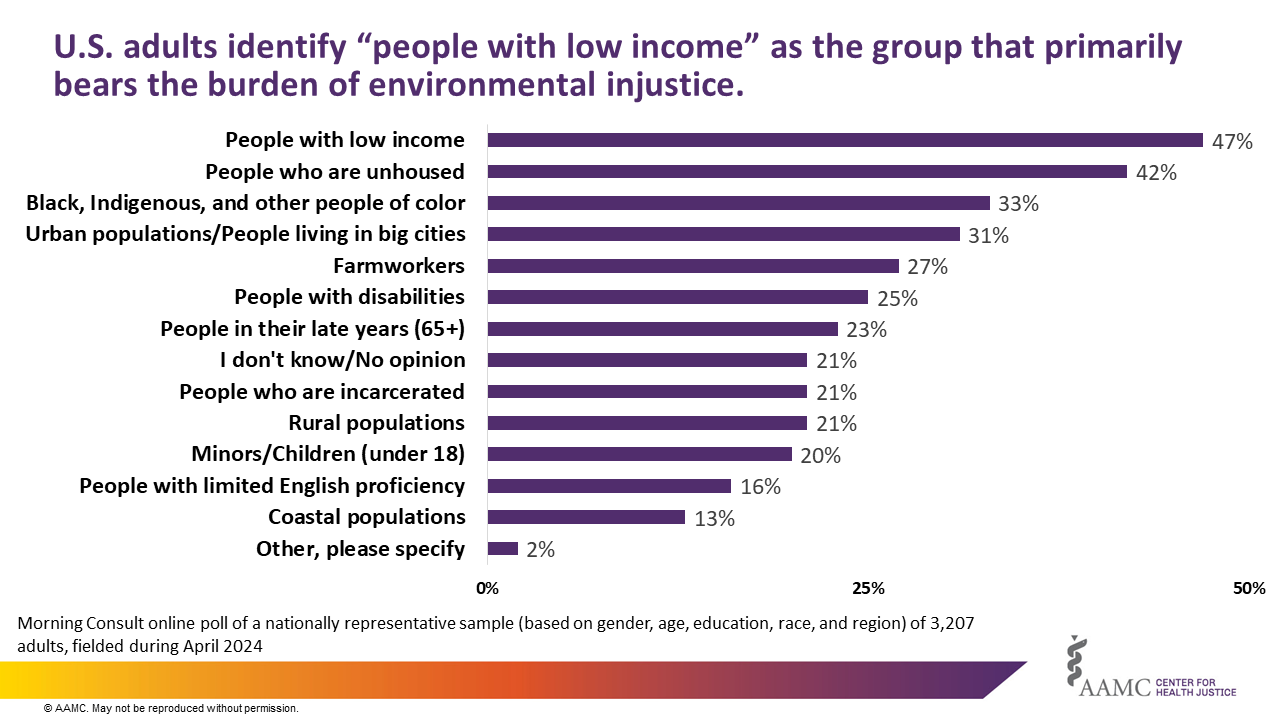
When asked who they think is responsible for creating environmental injustices, over half (52%) mentioned the federal government; 42%, state government; 42%, businesses/corporations; 40%, local government; and 22%, private (individual) citizens. Twenty-two percent (22%) of respondents said that environmental injustice does not exist.
Support for Environmental Justice
The Center for Health Justice, in collaboration with our Multisector Partner Group, developed a working definition of environmental justice to guide the Center’s work. For our poll, we used that guiding definition and described “environmental justice” as
“… the fair treatment and meaningful involvement of all people regardless of race, color, national origin, or income, with respect to the development, implementation, and enforcement of environmental laws, regulations, and policies.”
Overall, seven out of 10 U.S. adults agree with this goal. Liberals (81%), those who earn more than $100,000 per year (83%), baby boomers (76%), and those who reside in suburban (73%) or urban (71%) areas have higher levels of agreement with the goals of environmental justice overall (Figure 4).
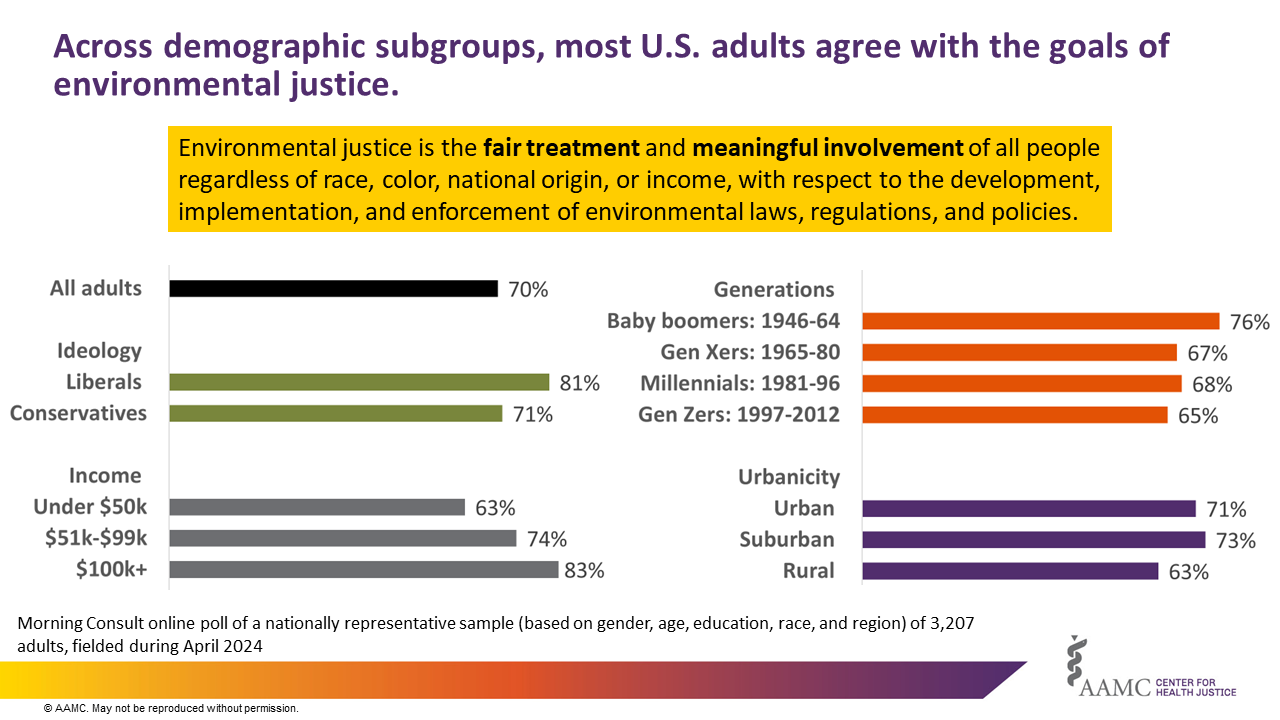
Awareness of Federal Efforts and Justice40
Recently, historic levels of federal funding have been allocated toward advancing environmental justice at the state and local levels. Much of this funding has been made possible through the American Rescue Plan, the Bipartisan Infrastructure Law, and the Inflation Reduction Act. The Justice40 Initiative,14 born out of Executive Order 14008: Tackling the Climate Crisis at Home and Abroad, serves as the primary mechanism for delivering these funds to communities, with a goal of ensuring that at least 40% of federal investments go to disadvantaged communities.15 16 17
Despite significant awareness of environmental hazards and injustice at the national level, and strong support for the goal of environmental justice, only 22% of U.S. adults are aware of any federal effort to advance it (Figure 5). Millennials (27%) and Gen Zers (25%) are more aware, along with liberal (30%), urban-dwelling (29%), and higher-income-earning adults (30%).
Sixty-two percent (62%) of respondents support Justice40 once they learn about it. Those who identify as liberals (82%), Asian Americans (73%), postgraduates (73%), those earning more than $100,000 annually (71%), and those living in urban areas (67%), expressed the most support.
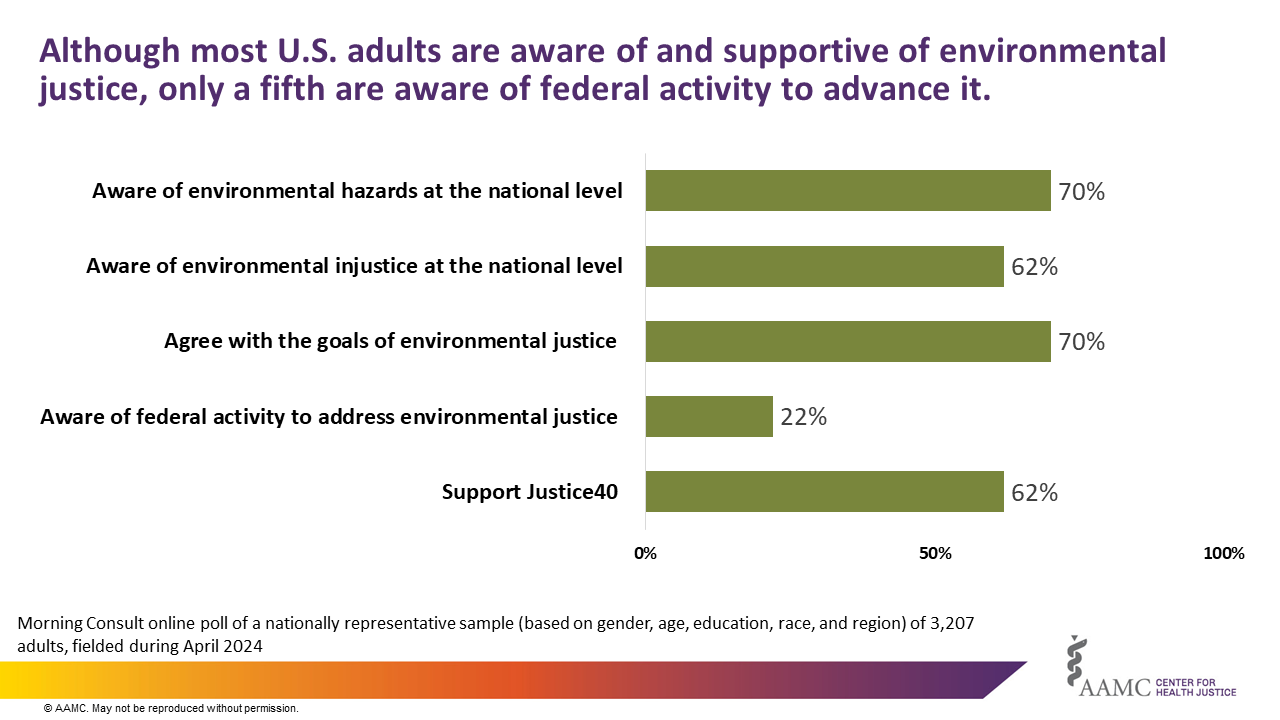
Justice40 Policies
The Center selected eight diverse Justice40 policies that could potentially address some of the most pressing environmental justice-related challenges. We then surveyed respondents about their level of support for these policies if at least 40% of benefits flowed to disadvantaged communities as outlined by the Justice40 initiative.
- Highways: Prohibiting the construction or expansion of highways.
- Electric Vehicles (EVs): Increasing the affordability of electric vehicles through tax credits and other financial incentives.
- Solar Energy: Incentivizing solar panel installation to ensure solar energy is the primary energy source for companies.
- Toxic Exposure: Providing funding to ensure toxic-exposure screenings are available to communities living in federally funded public housing.
- Healthy Food: Providing financial incentives for businesses to improve healthy food options (e.g., a farmers market, a grocery store).
- Parks: Providing funding for the rebuilding, recovery, and creation of parks and other green spaces.
- Water: Replacing lead pipe service lines to ensure safe drinking water.
- Affordable Housing: Increasing access to safe, healthy, and affordable housing.
Except for limiting the construction of new highways, all policies presented received support from the majority of U.S. adults. While self-identified liberals are more likely to support all eight policies presented, most conservatives expressed support for six of them, and five policies received support from seven in 10 conservative U.S. adults (Figure 6) (see supplemental table 3).
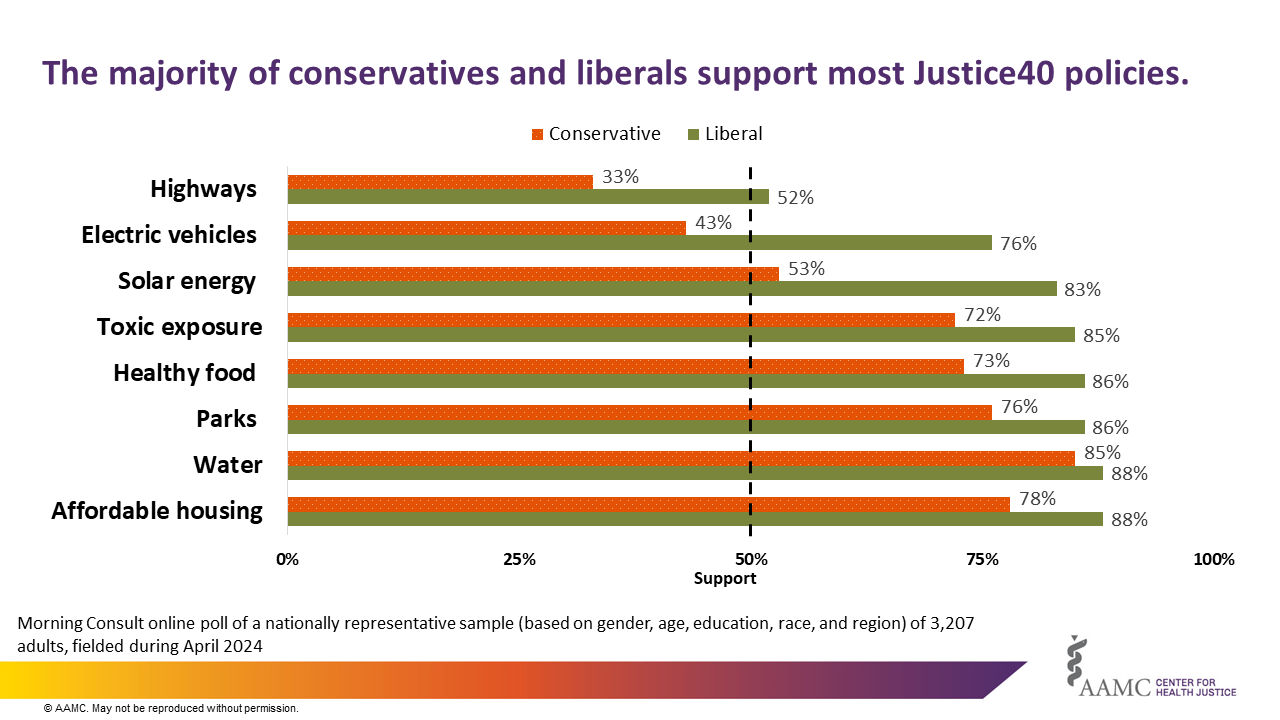
Considerations for Moving Ahead
Most U.S. adults, regardless of ideology, believe in the goals of environmental justice and the fair treatment and meaningful involvement of all people in the environmental policy decision-making process.
However, while most U.S. adults believe that environmental injustice is a problem across the nation, the vast majority are unaware of federal programs to address it. This is concerning, considering the significant investments the federal government has allocated over the past three years to address the issue of environmental injustice in communities across the country. Environmental justice champions should do more to raise awareness of and community engagement in popular federal actions such as Justice40.
Our poll also revealed important differences in how environmental injustice is perceived and how our framing of the issue impacts those perceptions. Evidence abounds that low-income communities and communities of color are most likely to be impacted by environmental hazards due to their unjust distribution.18 19 Results of our survey showed that U.S. adults recognize environmental impacts on both of these communities but are significantly more likely to identify lower-income groups than communities of color as disproportionately impacted.
Further, when the framing changes from hazards to injustice, recognition of who is more impacted by environmental threats drops by double digits. This corroborates what the Center’s recent polling on reparations revealed: The goals of health justice and environmental justice and the policies that would help to achieve them are popular but can be undermined by the way they are presented. We must deepen our connection to communications experts, marketers, and, above all, local communities to get our messaging right so our framing doesn’t undercut our shared goals and policy actions.
Importantly, environmental justice-related goals and actions are shared: Despite ideological divides, most conservative U.S. adults support environmental policies even when explicitly framed with the Justice40 requirement that at least 40% of the benefits accrue to so-called disadvantaged communities. Benefits of a thriving natural world accrue to all of us across generational, racial, economic, and other lines. Zero-sum rules do not apply. Building broad, “beyond the choir” support for popular policies with universal benefits should be a priority for environmental and health justice researchers, leaders, and advocates.
To that end, the AAMC Center for Health Justice is committed to creating space and time for the health justice community to think strategically about community engagement, messaging, and advocacy in support of environmental justice specifically and health justice more broadly. Together, we can match our messaging to our mission in a way that builds a movement, supported both by evidence and communities of all kinds, to ensure that all people have a genuine opportunity to thrive.
- Organizing around vital conditions moves the social determinants agenda into wider action, Health Affairs Forefront. Feb. 2, 2023. doi: 10.1377/forefront.20230131.673841. Back to text ↑
- Rosenberg M. Health geography I. Progress in Human Geography. 2013;38(3):466-475. doi:https://doi.org/10.1177/0309132513498339. Back to text ↑
- Brulle RJ, Pellow DN. Environmental justice: Human health and environmental inequalities. Annu Rev of Public Health. 2006;27(1):103-124. doi:https://doi.org/10.1146/annurev.publhealth.27.021405.102124. Back to text ↑
- Our poll defined “environmental hazard” as “… a substance, state, or event which has the potential to threaten the surrounding natural environment or harm people's health, including pollution and natural disasters such as storms and earthquakes. Some other examples of environmental hazards are poor water quality (polluted or unsafe drinking water), poor indoor/outdoor air quality (exposure to chemicals in the air), exposure to toxic substances (chemicals in playgrounds, herbicides and pesticides, poor industrial waste management), unsafe housing (rodent/insect pests, poor ventilation, lead-based paint, mold), and food-related exposures (pesticides, bacteria, viruses, hormones).” Back to text ↑
- Our poll defined “environmental injustice” as “the overexposure of communities of color and the economically disadvantaged to pollution, and its effects on health and the natural environment itself. The overexposure is due to the unfair distribution of resources and environmental protection, in part because of unfair regulations, governmental programs, policies, and enforcement of laws.” Back to text ↑
- Our poll defined “environmental justice” as “the fair treatment and meaningful involvement of all people regardless of race, color, national origin, or income with respect to the development, implementation, and enforcement of environmental laws, regulations, and policies.” Back to text ↑
- Lerner S. Sacrifice Zones: The Front Lines of Toxic Chemical Exposure in the United States. Cambridge, MA: MIT Press; 2012. Back to text ↑
- Cutter SL, Boruff BJ, Shirley WL. Hazards Vulnerability and Environmental Justice. New YorK: Routledge; 2012. Accessed May 31, 2024. Back to text ↑
- United Church of Christ Commission For Racial Justice. Toxic Wastes and Race in the United States: A National Report on the Racial and Socio-Economic Characteristics of Communities With Hazardous Waste Sites. Public Data Access; 1987. Back to text ↑
- Natter T. Yes, the environment can have racist effects, too. National Geographic Education. https://education.nationalgeographic.org/resource/yes-environment-can-have-racist-effects-too. Published Mar. 29, 2024. Accessed May. 31, 2024 Back to text ↑
- Berberian AG, Gonzalez DJX, Cushing LJ. Racial disparities in climate change-related health effects in the United States. Curr Environ Health Rep. 2022;9(3):451-464. doi:https://doi.org/10.1007/s40572-022-00360-w Back to text ↑
- Mascarenhas M, Grattet R, Mege K. Toxic waste and race in twenty-first century America. Environ and Soc. 2021;12(1):108-126. doi:https://doi.org/10.3167/ares.2021.120107 Back to text ↑
- Bullard RD. Dumping in Dixie: Race, Class, and Environmental Quality. Third Edition. 3rd ed. Boulder, CO; Westview Press; Published 2000. Back to text ↑
- The White House. Justice40: A Whole-of-Government Initiative. Published 2022. Accessed May 31, 2024. Back to text ↑
- Working from the Justice40 definition, our poll defined “disadvantaged” communities as “… the economically disadvantaged, Indigenous and people of color, people with limited English proficiency, people living in neighborhoods with significant environmental hazards, communities with substandard housing, etc.” Back to text ↑
- Department of Energy Office of Energy Justice and Equity. Justice40 Initiative. https://energy.gov/justice/justice40-initiative. Accessed May 31, 2024. Back to text ↑
- The White House. Justice40: A Whole-of-Government Initiative. https://whitehouse.gov/environmentaljustice/justice40 Published 2022. Accessed May 31, 2024. Back to text ↑
- NRDC. What Is Environmental Racism? https://nrdc.org/stories/what-environmental-racism. Published May 24, 2023. Accessed May 31, 2024. Back to text ↑
- Bullard RD. Dumping in Dixie: Race, Class, and Environmental Quality. Third Edition. 3rd ed. Boulder, CO; Westview Press; Published 2000. Accessed May 31, 2024. Back to text ↑


